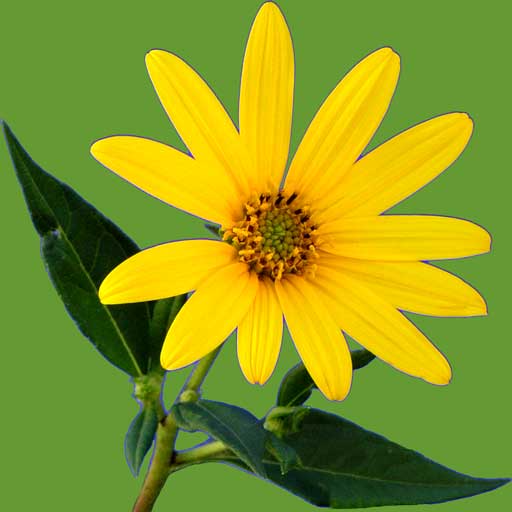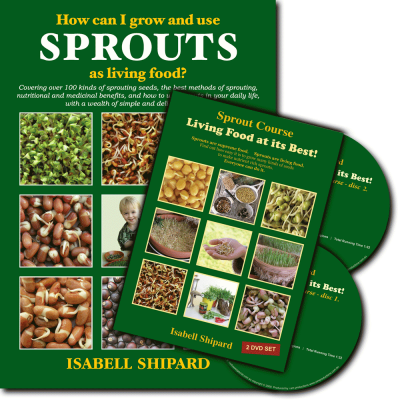Helianthus annuus F. Asteraceae
Description and Sprouting
The generic name, Helianthus, is derived from Greek ‘helios’ meaning the sun, and ‘anthos’ meaning a flower. The common name, ‘sunflower’, is a most appropriate name, as the large, round yellow flowers, are as bright as the sun. A fast-growing annual, 1-3m high, developing a deep taproot. Above ground, it forms a stout, erect, fibrous stem and alternately forming, large, heartshaped, hairy leaves 30cm long, with toothed margins.

The bright, cheery, flower heads, 8-40cm in diameter, create a magnificent display. There are over 50 helianthus species, as well as many developed varieties. Some have dark yellow centres; others are dark brown, with ray florets in varying shades of yellow. Flower heads can fill out and become so heavy that the stems sometimes need staking, to support their weight. Bees love to visit the flowers, collecting nectar and wax. When the flowers have faded, the round centre develops a superb, symmetrical pattern, with plump, black or black and white striped seeds, ovate in shape, to 15mm long. When the seeds have filled out and the flower top turns brown, the heads are ready to pick and be hung, to completely dry out.
To sprout unhulled seed, follow the tray procedure page 32, using soil or potting mix on a tray. When buying unhulled seeds, look for large, plump seeds, as the sprouts will be strong and tall. Some people find the packeted sunflower seeds sold as parrot seeds, sprout well and are good value. Seeds germinate quickly and will be ready to cut, at soil level, in 6-9 days. Seedlings, at their two-leaf stage, are referred to as sunflower ‘lettuce’. If left to grow any older they are bitter and rather unpalatable.
To sprout hulled sunflower seed, go through the seed, take out (and eat) any damaged, broken seed. After purchasing hulled sunflower seed, store in refrigerator, as seed can oxidise quite quickly. Soak the sorted, whole seed, 8-10 hours. Drain off the water and, with fresh water, carefully rinse away all the loose, transparent, thin skins that covered the seeds. Removing this skin, with several rinses of water, is important, particularly when the weather is hot, as the skin can ferment and spoil the whole batch of sprouts. The soaked seed is now germinating and is very delicious at this stage: crisp, sweet, nutty and already starting to shoot after 10 hours. Eat at this stage, or place in a jar or saucer; keep moist for another 24 hours and eat.
Constituents:
phytosterols, oils include linoleic acid, 60% and oleic acid 30%, coenzyme Q 10, saponins, albumin, lecithin, betaine, quercimetrin, tannins, sesquiterpenes, pectin, lignans, protein 24-30% with 8 essential amino acids (amino acid score 81, moderately low in lysine)
Vitamins:
A, B1, B2, B3, B5, B6, B12, B15, C, D, E, F, H, K, choline, folic acid, inositol, PABA
Minerals:
calcium, cobalt, copper, fluorine, iodine, iron, magnesium, manganese, phosphorus, potassium, selenium, silicon, sodium, sulphur, zinc
Actions:
anti-inflammatory, antifatigue, antimicrobial, antioxidant, diuretic, expectorant, galactagogue, hypolipidemic, nutritive, tonic
Medicinal Uses
Research has found the essential fatty acids (EFA), in sunflower seeds, provide a beneficial action in cleaning arteries, reducing LDL cholesterol levels and preventing heart disease. Sunflower seeds have a medicinal use for: arthritis, rheumatism, headaches, blurred vision, high blood pressure, fluid retention, fevers, bladder and kidney inflammation, bleeding gums, bronchitis, nervous stress, coughs, colds, asthma, duodenal ulcers and cancer. A liniment from the sunflower head is applied externally for relief from arthritic and rheumatic pain. As sunflower sprouts have a warming, thermal nature, we can use them during the winter months to great advantage, and also for lubricating the intestines and treating constipation, fatigue, and to strengthen the spleen and pancreas.
The seeds have a very high content of calcium, phosphorus, magnesium and vitamin D, the vitamin, which is often called the key to unlock the door, allowing calcium to leave the intestine and enter the blood stream. This makes it an important nutrient for building strong bones, tendons, muscles, teeth, hair, skin, nails and eyesight. 100g of seeds provides 7.2mg of iron, making sunflower seeds, richer in iron than almost any other foods, except egg yolks and liver.
Scientists have found that the pectin, from the seed, can have the effect of expelling radioactivity from the system, which offers a greater protection against the build-up of strontium 90 in the bones. The seeds are one of the best natural foods that we can eat regularly, as they supply many vital nutrients needed for growth and repair. It is said that it would be possible to live on sunflower seeds alone, for an extended period, should there be a time when a survival food is needed.
The Russian Academy of Science found that sunflower oil… 1 tablesp. of oil when swilled in the mouth for 15-20 minutes, activates the salivary glands and stimulates enzyme release. Toxins from the circulatory and lymphatic systems are also released, via the oral salivary glands. The oil should not be swallowed. Empty the mouth by spitting. This simple procedure has the remarkable benefit of helping the body detoxify; it has relieving and healing effects on a wide range of conditions and can be used regularly, by anyone wishing to keep their immune system working well.
Culinary Uses

Pesto made with sunflower sprouts, Greek basil, Lebanese cress, nasturtiums, garlic, cheese and olive oil, rolled in coriander seed (recipe p 115).
Pesto made with sunflower sprouts, Greek basil, Lebanese cress, nasturtiums, garlic, cheese and olive oil, rolled in coriander seed (recipe p 115).
Sunflower seeds provide our diet with a good source of polyunsaturated fat. Eat the sprouts as a snack, fresh in hand, or in salads. I like eating the hulled sprouts over muesli, for breakfast. The hulled seed sprouts are made into sprouted seed cheese. Sprouting the seeds, rather than eating the dry seeds, provide a number of health benefits. Due to the enzymes that are activated during sprouting, the sprouts are more easily digested than the dry seeds. The sprouted seed has vitamin C, while the dried seed has none. The B vitamins can increase – anything from 100-600% – from the dried seed state to the sprouted seeds. Dried seeds are acid forming to the body, whereas sprouted seeds are alkalising.
When we sprout the seeds, they become living food…what can be better than that!
Use sunflower lettuce in sandwiches, pita bread, taco shells, tossed salads, as a garnish or add to vegetable juices. The sprouted greens are a richer source of vitamins than the dried seeds and they also develop vitamin B12. Young leaves of sunflower lettuce are rich in chlorophyll (a valuable blood builder), lecithin, vitamins, minerals and life-force energy. Grow sunflower lettuce regularly, and when sprouted ready to use, at 5- 10cm length, place the container on the table, so that the sprouts (‘lettuce’) can be nipped off with the fingers and enjoyed any time through the day, as a nutritious ‘good-for-you’ snack… they are crunchy and delicious.
To make sunflower milk soak hulled seed in water, 3- 4 hours, and blend in a food processor until smooth. Add several dates, to make a sweet-flavoured milk, if desired. Alternatively, use 1-2 day sprouted, hulled seed to make the milk.
Try a sunflower sauce using 2 cups sunflower lettuce, 1/2 avocado, juice of a lemon, 1 teasp. herb salt and 1/2 cup of any green, leafy herbs, like rocket, mint, Lebanese cress, arracacha or watercress. Blend to a smooth, runny consistency, adding water as required. Garlic may also be added if desired. Serve the sauce over vegetables or a sprout salad.
Sunflower lettuce salad Combine 1 cup sunflower lettuce, 2 small grated carrots, 1 small diced onion, a finely cut stick of celery and serve with a dressing.
Sunflower and carrot muffins (p 74) In a bowl combine 2 lightly beaten eggs, 2 teasp. vanilla essence, 1 cup 1-2 day old sunflower sprouts, 2 cups finely grated carrots, 2/3 cup brown sugar, 2 teasp. cinnamon, 2 1⁄4 cups wholemeal flour mixed with 1 tablesp. baking soda, 1⁄2 cup unrefined sunflower oil or olive oil, 3 tablesp. water, 1 cup currants, sultanas or raisins. Spoon mixture into muffin pans; bake in pre-heated oven at 160°C (325°F) for 35 minutes. A toothpick inserted in a muffin, will come out clean, when the muffins are done. Do not overcook, or muffins may be dry.
And for other plants in the Asteraceae family.
… … omitted text, please see How can I grow and use Sprouts as living food? for full text.


